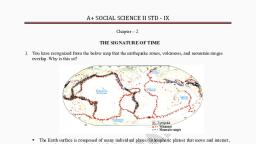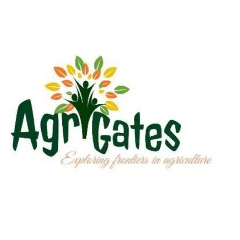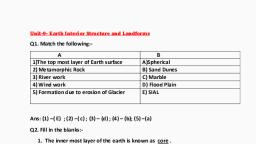Page 1 :
STANDARD NINE, , GEOGRAPHY, , 156
Page 2 :
© Learning Objectives, , To know about the spheres of the Earth, , To study the rock types and its cycle, , To illustrate the internal structure of the Earth, , To explain the internal processes of the Earth, To understand the processes of Earthquakes and volcanoes, , , , , , , , , , , , , , , , , , , , , , reo, , I, , Oo —, FDCAVY, , , , , , | Introduction, , The Earth is a unique planet of the, Solar family. The Earth is composed of four, spheres namely, the lithosphere, the, atmosphere, the hydrosphere and the, biosphere. This lesson focuses on the, internal processes of the Earth. The, sequence of lessons generally follows, the spheres of the Earth system in a, comprehensive manner., , Have you ever wondered what our Earth, is made up of? Or what lies underneath the, Earth's surface?, , “The Earth can physically bedescribed ;, asa ball ofrock (the lithosphere), partly, covered by water (the hydrosphere), and wrapped in an envelope of air, (the atmosphere). To these three, physical zones it is convenient to add, a biological zone which includes all, the living organisms (the biosphere).”, , Arthur Holmes, , | |W. GovT.1 8a Gengaphy Chott 157, , 157, , | 1.1 Bogor eae tla, , Earth's surface is a vast area of, 510 million sq.km, where four spheres of the, Earth interact. The abiotic spheres are the, lithosphere, atmosphere and hydrosphere., The biotic sphere is the biosphere. Together,, these spheres constitute the planet, Earth., , | 1-2 EEE, , The outer surface and inner core of the, Earth are totally different in their nature and, structure. The structure of the Earth’s interior, is divided into three layers namely the crust,, the mantle and the core., , , , Spheres of the Earth, , 1. Lithosphere - I Endogenetic Processes, , rotans rosie | |
Page 3 :
The is the solid outer part of, the Earth., , The is a thin layer of, gases that surrounds the Earth., , The is the watery, part of the Earth’s surface including oceans,, rivers, lakes and water vapour, , The is the layer of Earth, where life exists., , Beale wo len ge) i, fo) i | a |, , LAYERS, , Peron, , Crt, , Crust is the outer layer of the Earth,, where we live. It is the skin of our Earth, which, ranges between . It is the solid, and rigid layer of the Earth. The thickness, of the crust is greater below the continents, than the ocean floor. The crust is classified, as and The, major elements of crust SIAL are Silica (Si), and Aluminium (Al) and SIMA (Si - Silica, and - Magnesium), , Lithosphere - I Endogenetic Processes, , | | ®N-GovT.D 8a Gengaphy Chon 158, , , , , , The terms and, Do. are not the, , NY The, KNOW?, , same., lithosphere includes, the crust and the uppermost, , part of the mantle., , All terrestrial planets have, lithosphere. The lithospheres of Mercury,, Venus, and Mars are much thicker and, , more rigid than that of the Earth., , Bers, , Sood, , Continental Crust is made up of SIAL and, Oceanic Crust is made up of SIMA, , , , rotans rossi | |
Page 4 :
Mantle, , The interior part beneath the crust is, called mantle, which is about 2,900 km thick., The major elements of the mantle are Silica, (Si) and Magnesium (Mg) and hence it is also, termed as SIMA. In the upper part of the, mantle, the rock remains solid, whereas in the, lower part of the mantle, rocks are in molten, form. This molten rock inside the Earth is, called ‘magma’., , Core, , The core is the innermost and hottest, layer of the Earth which lies below the, mantle. It is composed mainly of Nickel (Ni), and Iron (Fe). Hence it is called NIFE. The, core is divided into Solid inner core and, Liquid outer core. The presence of large, quantities of iron in the core is responsible, for the Earth’s gravitational force. As the, Earth rotates on its axis, the liquid outer core, spins over the solid inner core and generates, the Earth’s magnetic field. This is responsible, for the functioning of the magnetic compass., Due to high pressure, the materials in the, inner core are unable to move and hence, remain solid., , [23, , The crust is a storehouse of rocks. An, aggregate of minerals on the Earth's crust is, called ‘rock. It may be hard and compact like, ‘granite’ or soft as ‘clay’ or loose as ‘sand., , » The Deepest Place, ~ever reached by human, ve technology vary from time, , to time. Till 2011 Kola, , Super Hole (12,262m), in Murmansk, Russia was the deepest, place. But in 2012, Z-44 Chavyo Well, (12,376m) broke the record, and is, supposed to be 15 times the height of, Burj Khalifa in Dubai.The exploration, of Earth’s interior continues., , | | N-GovT.1 8a Gengaphy Chon 159, , 159, , Types of Rock, Based on formation, rocks are classified as:, , ™ Igneous,, ™ Sedimentary and, , ™ Metamorphic., , The ancient city of Petra in Jordan is an, example of an entire city carved out of rocks., There are many specimens of magnificent, rock-cutarchitecture in India, likethe Ajanta, and Ellora caves in Maharashtra, the Aihole, and Badami temples in Karnataka, the, Konark temple in Odisha and, Mamallapuram in Tamil Nadu., , Igneous Rocks, , The word ‘igneous’ is derived from, the Latin word Ignis meaning ‘Fire’ The, interior of the Earth contains very hot molten, material called ‘Magma’ When the magma, reaches the Earth’s surface, it is referred to, as ‘Lava’ The lava on the surface cools down, and gets solidified as rocks called igneous, rocks. Granite and basalt are examples of such, rocks. Igneous rocks are also called Primary, or Mother rocks because all other rocks are, directly or indirectly formed from them., , Sedimentary Rocks, , These sedimentary rocks are named, after the latin word ‘sediment’ meaning, " settle. Rivers, glaciers and winds carry, bits of rock and soil and deposit them in, layers. After a few million years, these, deposits harden into compact rocks and, are called Sedimentary rocks., , The bodies of plants and animals that fall, on the deposits get embedded in the layers, and form Fossils. Sandstone, limestone,, chalk, gypsum, coal and conglomerate are, examples of sedimentary rocks., , 1. Lithosphere - I Endogenetic Processes, , rotans rossi | |
Page 5 :
Metamorphic Rocks, , The term ‘metamorphic is derived, from the word ‘metamorphosis, which, means, ‘change of form. When igneous or, sedimentary rocks are subjected to extreme, heat and pressure, they undergo a complete, change in their form and character .i., course of time, granite may get transformed, to gneiss, basalt to schist, limestone to marble, and sandstone to quartzite., , , in, , , , Rock Cycle, , The Rock cycle is a continuous process, through which igneous, sedimentary and, metamorphic rocks are transformed from one, form to another., , Igneous rock, , Crystallization, ‘of magma, , , , Activity, , Narrate the processes involved in the, given rock cycle diagram in your own, words., , | i. Geomorphic Processes, , The forces that act from the Earth’s, interior towards the Earth’s surface are, called Internal processess or Endogenetic, processes. These forces build the landscape, and create topographic relief., , The forces that act on the surface of, the Earth due to natural agents like running, water, glacier, wind, waves etc. are called, External processes or Exogenetic processes., These external processes tear the landscape, , 1. Lithosphere - I Endogenetic Processes, , | | N-covT. su Gengaphy Chon 60, , 160, , down into relatively low elevated plains, and shapes the landform created by, Endogenetic process., , Internal Processes, , , , The internal processes, generate heat and eject, materials from deep below, the Earth’s crust. Internal, radioactivity is the, principal source of power, for this process., , , , , , , , fa, FDL6XI, , , , Plate Tectonics, , The lithosphere is divided into a number, of huge slabs of rocks called “Tectonic, plates? These tectonic plates are divided into, major and minor plates. These plates float, independently over the mantle. Collisions, of these plates produce mountain ranges, and other irregular surface features, both on, land and the ocean floor. This phenomenon, is called ‘plate tectonics. The movement, of tectonic plates is due to thermal energy, from the mantle. Now we have a better, understanding about the plate movements, and its relation to Earthquake and volcanic, activities., , Types of Plate Boundaries, Convergent Boundary - Here the plate moves, toward each other and sometimes, a plate, sinks under another. The location where the, sinking of a plate occurs is called a subduction, zone (eg) Fold Mountain-Himalayas., , , , Convergent, plate, boundary, , Divergent Boundary - Here the plates pull, away from each other as magma pushes up, from the mantle (eg) Mid Atlantic Ridge, , Neo, , oxosane nassr | |












































